The first thing I noticed about Pawtuckaway State Park was its lush landscape and abundant wildlife. Everywhere I turned, I noticed new fauna and interesting flora. One of the coolest parts about being an Interpretive Ranger is that park visitors love to come up and tell me about their wildlife encounters! I wanted to make this post about all of the magnificent animals in the park. What better way to do it than enlist the help of park visitors themselves? Over the past couple months I have been asking campers and day-users to send me photos of wildlife they took during their stay. Here are some of my favorites:
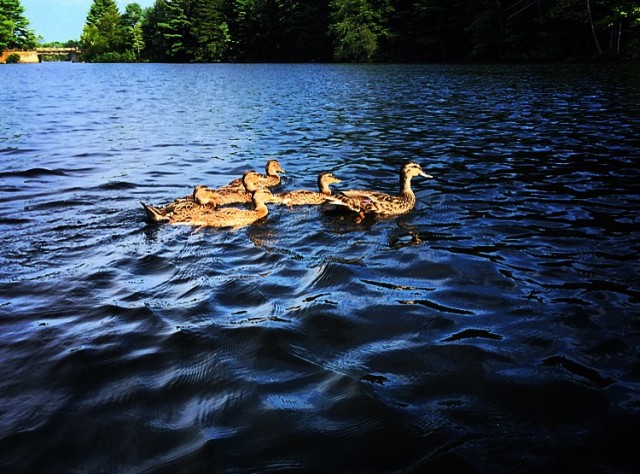
Amy snapped a photo of this adorable duck family while she was canoeing.
“It was a beautiful day” she says, “and we were excited to share the water with these natural swimmers.”
They followed her around for a few minutes while she was paddling around! Pawtuckaway is a fantastic destination to see some wildlife on the water. You can rent canoes, kayaks, and paddleboards by the camp store and spend the day cruising around the lake. Who knows what you might find!
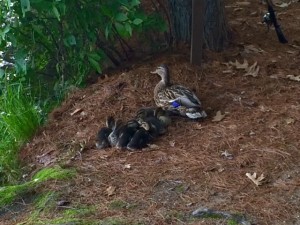
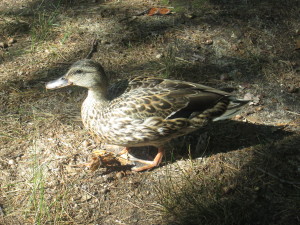
Lyndsie and Debra also came upon some ducks during their time at the park! Just as a friendly reminder, remember to never feed wildlife. Ducks at Pawtuckaway are certainly not afraid of humans since they are used to being fed. While it may seem as though feeding them is helping them, in the end it does more harm than good. We want to refrain from altering their natural behavior and diets in any way. Enjoy watching these funny creatures from afar and keep the snacks for yourself.
Picture this: I’m reading in my tent at dusk. I start to hear something approaching my campsite. As the sounds get closer, I wonder what it could be… doesn’t sound like a racoon, definitely not a skunk, but it’s certainly something larger than a squirrel. Wait a moment, there must be a dozen of them! It sounds like a group of kids sneaking through my campsite! Could it be the boy scout group that is staying in the campsite down the trail from me? My curiosity gets the better of me, so I get out of my warm sleeping bag and peer out. Right in front of my eyes I see a group of over 15 turkeys casually strutting past my tent!
Shelby and Jeff each had their own moment with a group of turkeys, and luckily they was able to snap a photo of them. Turkeys wander through Pawtuckaway in search of insects, seeds, acorns, worms, or some leftover food scraps from the human visitors.

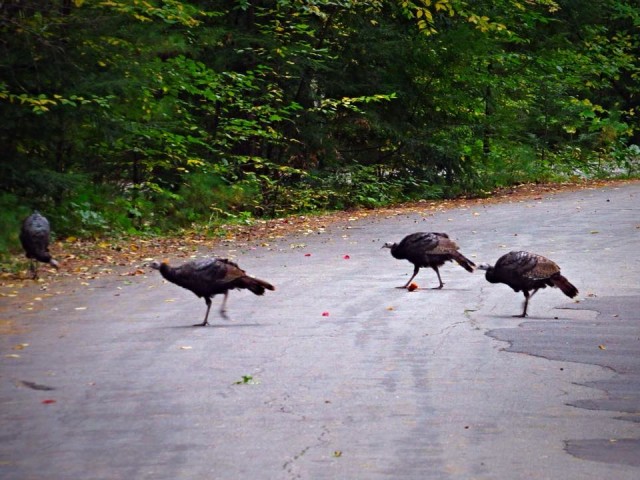
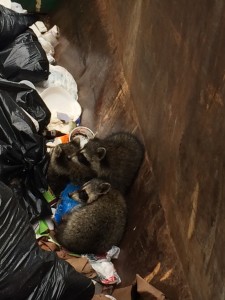
Shelby caught another pair of scavengers on camera. Raccoons are the number one animal that I see on my campsite. Just about every night I hear the familiar sound of a raccoon waddling through the site in search of leftover food. You’d be surprised at how many place they can get into. Their fingers and hands are so nimble that they can untie knots and undo zippers. These are some smart creatures; on the IQ scale they fall somewhere between cats and monkeys!

Josiah excitedly emailed this photo of a beautiful butterfly.
“I want to find out what kind of butterfly this is” he says, “because it is the most beautiful one I’ve ever seen!”
Well, Josiah, lucky for you there are some great dichotomous keys out there for insects! If any of you come across an animal and you want to identify it, simply search for a dichotomous key. It’s the easiest way to discover what wildlife you have encountered! This is a Morning Cloak butterfly. Its special markings are unlike any other butterfly, so it’s a very distinctive creature.
Speaking of identifying creatures, I need some help figuring out what caterpillar Logan came across! It’s very unique looking with those black lines running along the body and the single yellow tail. Any caterpillar experts out there? Thanks Logan!
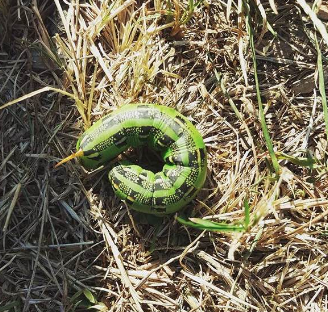
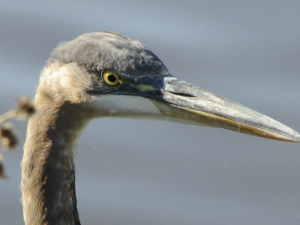
This gorgeous shot of a blue heron was my favorite submission. I bet this heron was wading through Burnham’s Marsh in search of food. Standing at 3 feet tall, these creatures are wonderful fisherman; they use their long legs to stand above the water and wait for fish or other critters to swim by. A heron can swallow a fish many times wider than its neck.
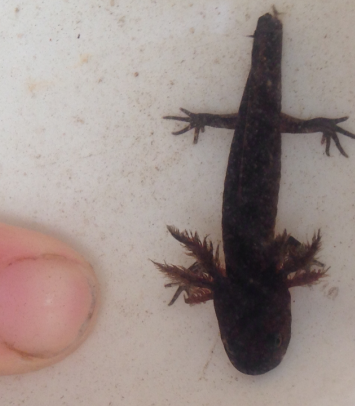
“I don’t know if this is cheating” says Penelope, “but I thought this salamander larva was the coolest thing at your program!”
I agree with Penelope; I love it when we catch Eastern Newt larvae during my “Creatures of the Marsh” program. These critters have a fascinating life cycle. They start off in the water as larva (pictured above). At this point in their lives, they have external gills and can only breathe underwater. After about a year, they morph into the red eft form. You may have seen these terrestrial salamanders under logs or rocks. During this stage, they lose those gills and can no longer breathe underwater. They form lungs so they can breathe in the air. Finally, after about 5 years they return to the water as the full-grown adult. In this stage they can breathe both in and out of water!
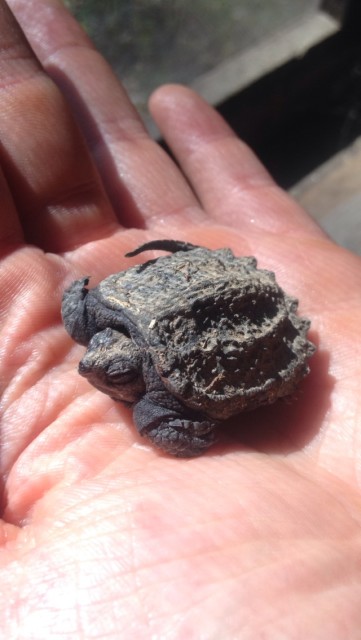
Finally, here’s my personal contribution: a snapping turtle hatchling. He was found on dry land, likely in search of a new water source. These turtles are ancient! The common-day snapping turtle evolved around 40 million years ago (compare that to modern-day humans who evolved a meek 200,000 years ago). Did you know that the sex of a turtle is determined by temperature? Warmer snapping turtle eggs tend to be females, while cooler eggs form into male snappers. Do you think that female turtles will lay her eggs in a certain area to create an outcome of a certain sex? Some scientists think so!
Thank you all for your contributions! It brings me joy to know that so many folks are fascinated with wildlife and have taken time to document it. I encourage you all to keep your eyes peeled every time you go outside… you never know what could be lurking around the corner!
Happy exploring,
Renee Harding,
Pawtuckaway State Park Interpretive Ranger

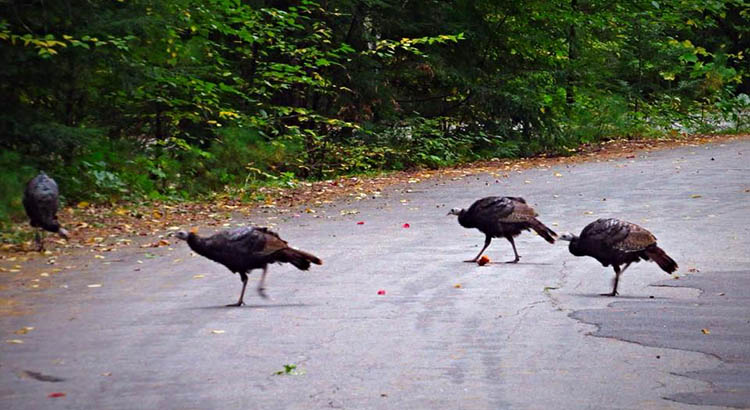
Great job this past summer. My grandchildren attended a couple of your programs. I’ve been going to the Paw for 30 years. (Usually site 48) It is the best for camping and fishing. I have many wildlife pics including several of the eagle that has been seen at the park for the past 3 or 4 years. I would love to send them to you if you are still accepting pics. keep up the good work.